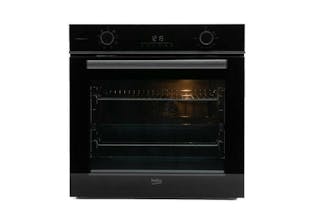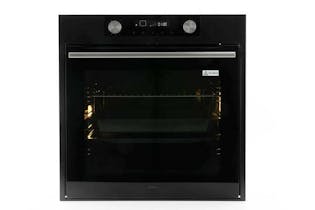How to clean your oven (with or without a self-cleaning feature)

My only experience with chemical oven cleaner was ghastly. The first squirt erupted with a suffocating cloud of noxious fumes. Eyes squeezed shut and breath held, I scrambled to the nearest window and leaned out, gagging for air. I had to finish the job, but I’ve never used the stuff again.
But oven cleaning is a task that’s simply got to be done from time to time. A dirty oven can affect the flavour of food and emit horrible smells and smoke. Fortunately, there are a few oven features and cleaning tricks that’ll help you get the job done without making a stink.

Self-cleaning oven features
To ease the pain of cleaning, many modern ovens come with catalytic liners or a pyrolytic cleaning function, and some have a steam clean cycle. While you’ll still have to do a little work, these handy features make the job much easier and don’t need nasty chemicals.
Catalytic liners

Catalytic liners absorb and burn off fat splatters during use, so you don’t have to spend hours scrubbing. But they usually don’t cover all internal surfaces, so you’ll have to manually clean areas that aren’t lined.
They’re easy to maintain. Just heat your empty oven to 250°C from time to time. It’ll take about an hour to burn off any residual grease. Once cool, use a damp cloth to wipe the liners and collect any fallen ash. When looked after, catalytic liners should last a long time but might need replacing at some stage.
Pyrolytic cleaning

Often referred to as self-cleaning, some ovens have an ultra-powerful pyrolytic cleaning function. It heats the oven to 400°C–500°C, burning off food residue, leaving only ash. Once the oven cools, wiping or vacuuming the ash out is easy. A pyrolytic cycle runs for about one to four hours, depending on the oven’s settings.
Before you start, wipe away loose food debris. You should also remove runners, racks and other parts that aren’t pyrolytic safe.
The door will be locked during the cycle, but the oven exterior can get extremely hot. You should remove towels from the door rail and keep children and pets out of the kitchen.
Pyrolytic cleaning can produce smoke – more for dirtier ovens. Switch on the rangehood, open windows and close internal doors to vent fumes and heat outside.
Steam cleaning

Steam cleaning is far less intense than a pyrolytic cycle. Manufacturers often give it a proprietary name, such as SteamShine, EasyClean or Vapour Clean. But they all do the same thing – heat water (sometimes with a little vinegar or dishwashing liquid), which converts to steam and softens food residue.
It usually takes 20–30 minutes to work. Once the oven cools, you can wipe away the softened gunk. You might need to scrub stubborn grime with a little dishwashing liquid.
DIY oven cleaning
If your oven doesn’t have a pyrolytic cleaning function and steam cleaning hasn’t worked, you might be considering a chemical-based oven cleaner. But this should be a last resort.

Oven cleaners made with powerful chemicals can cause serious skin burns, eye damage, and potentially harm airways. There’s a reason we want to run for the door when we use them. They can also damage certain oven components.
Ideally, you’ll use safer substances – see Clean your oven with home ingredients below. If you’ve given that a go and your oven still clings to layers of grease and grime, here’s how to safely use a chemical-based oven cleaner.
- Read the oven’s manual: Checking the manufacturer’s recommendations will minimise the risk of damaging your oven or voiding its warranty. Requirements can vary between brands and models.
- Protect yourself: Buy a disposable mask, safety glasses and a pair of long, chemical-resistant gloves to protect yourself from fumes and chemical burns. Consider covering your clothing and putting newspaper on the floor in front of your oven too. When you’re ready to clean, switch on the rangehood and open the windows. Close internal doors so fumes don’t waft into bedrooms and living areas. Keep kids and pets away too.
- Prepare the oven: Make sure the oven is switched off at the wall and cool (unless the oven manual and recommended cleaner suggest a warm oven). Remove all bakeware, trays and racks, plus any removable rack supports and catalytic liners. Wipe the oven out to remove loose food crumbs.
- Apply cleaner: Follow the directions for the oven cleaner. Avoid spraying heating elements, catalytic liners, and door window glass to prevent damage. Steer clear of the fan too – spraying into its unreachable areas can result in lingering stink and tainted meals.
- Allow time for the cleaner to work: Once you’ve coated all suitable surfaces, close the oven door, and leave it to sit. The cleaner packaging should state the sitting time – usually about 30 minutes for a cold oven.
- Wash the components: While the cleaner does its work, wash the oven racks and any other parts you removed. Soak them in a sink with hot water and dishwashing liquid. Scrub off grease, rinse well, and dry.
- Wipe out your oven: When the wait time’s up, wipe out the oven with a damp cloth, frequently rinsing as you go. Remove any tinfoil used to protect components. A final wipe with paper towels will confirm cleanliness and help the oven dry.
- Clean the oven door: Vacuum loose crumbs from around the door, then clean the window glass with hot soapy water. If it’s still greasy, try using a glass cleaner.
- Piece your oven back together: Return any items you removed back to the oven, starting with anything that needs screwing back into place, such as catalytic liners and runners.
- Air out the oven: To help everything dry, heat the oven to about 100°C for 20 minutes. Leave the door ajar so the moisture can escape.
- Clean any storage areas: Wipe out any drawers below the oven as they can catch crumbs and drips. Wash oven mitts and other stored items too.
- baking soda
- water
- white vinegar
Put the oven cleaner’s lid securely back on and store it well out of reach of children and pets.
Clean your oven with home ingredients

You can make a cleaning solution with ingredients you probably have at home. It won’t be as powerful as chemical cleaners, so you’ll need to do a little scrubbing. But it’ll be safer and less offensive to use.
You’ll need:
plus a gentle scrubber, cloth, spray bottle, and gloves.
Mix about half a cup of baking soda with enough water to make a thick paste. Spread it over the oven interior, avoiding heating elements. You can use it on oven racks and other removed components too.
Let the paste sit for several hours, then spray vinegar over the pasted surfaces. This causes fizzing that loosens grime.
Scrub surfaces with a little warm water, then wipe clean with a damp cloth.
How often should you clean your oven?
If you don’t use your oven much and wipe up any spills when they happen, cleaning your oven once every few months will be enough. But if you use it daily or cook foods that splatter, clean it monthly.
Regular cleaning is also easier than tackling age-old grime, so it’ll reduce the need to use chemical oven cleaners.
Check out our built-in and freestanding oven test results, and see which ovens have the self-cleaning features you want.
We've tested 36 built-in ovens.
Find the right one for you.
Beko


.jpg&w=315&q=75)
Member comments
Get access to comment